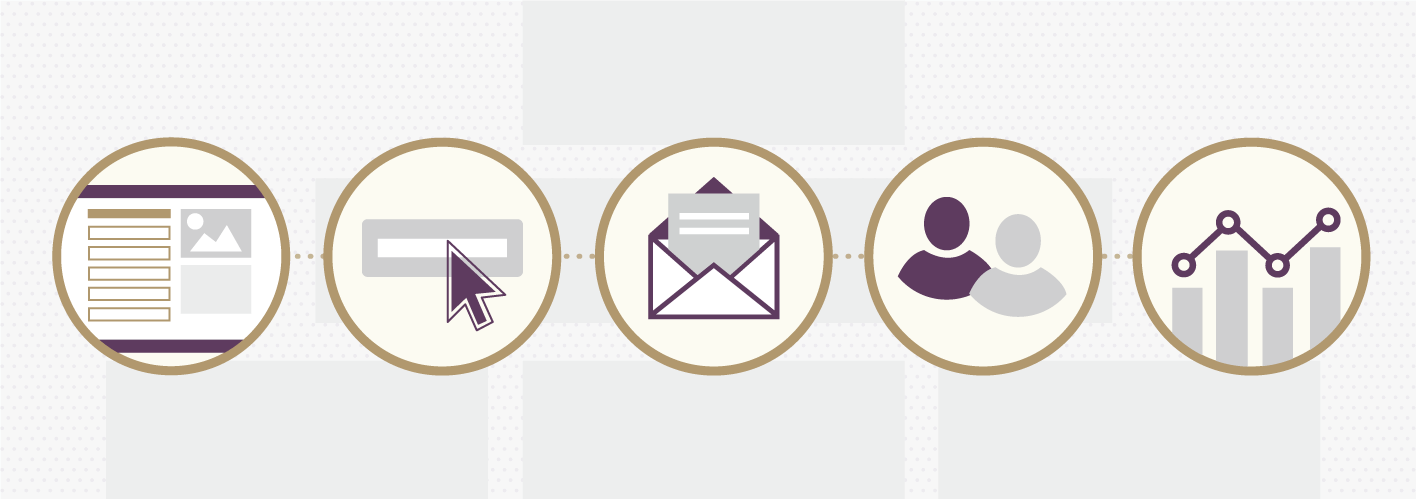Not too long ago I wrote about auditing your marketing automation setup in a two-part post. But what if you’re just getting started and don’t really have anything to audit just yet? The focus at that point can be building a solid foundation for your marketing automation strategy. From the initial promotion of an offer on your site to the subsequent touchpoints you’ll have with a lead, this post will lay out a fundamentally sound campaign that makes your marketing automation platform work for you, regardless of what system you’re using.
Build your offer
The hub of a basic digital marketing campaign is the landing page. It promotes an offer and explains what the reader is getting in exchange for their contact information. It’s the moment where a visitor turns into a lead or decides that they aren’t interested enough to fill out the form. In short, it’s the lifeblood of your marketing automation system because it keeps pumping in new leads or gathering more information about existing ones.
Nearly every marketing automation platform out there makes it easy to create these pages, but just because you get a pre-built template doesn’t mean you should use it. Make sure the offer is compelling and clear. Experiment with page layouts, copy and imagery selection, color choices, etc. Figure out what configuration works best to generate leads for your business.
In addition, consider the requirements for someone to access the offer. Requiring someone to fill out 15 different form fields would create a fairly substantial conversion barrier, because that’s pretty intrusive and demanding. On the flip side, only asking for someone’s email address probably leaves value on the table in terms of building out your contacts database. Find a good balance that reflects the amount of value someone will get by filling out the form.
Point people to the offer
It can be discouraging to build a great landing page that’s promoting an outstanding offer, and then not have any leads come in through it. But that’s where a lot of people miss the mark when it comes to maximizing the value of marketing automation. If people don’t see your offer, people won’t become leads from it. Organic reach via search rankings can help with this to an extent, but you shouldn’t fully rely on it to drive campaign results.
Consider your audience and develop a strategy for getting your offer in front of them. Some of the “free” options include placing calls-to-action and text links promoting the offer throughout your website and blog. You can also share it on your company’s social profiles as well as your own. But if you’re looking for large-scale exposure, paid promotion is your best bet. Everything from LinkedIn Sponsored Updates to paid search placement is fair game — your final selection depends on your specific audience and how they seek out information.
As you finalize your promotion strategy, be sure that you’re adding the necessary tracking parameters. That way you’ll be able to tie results back to the channels that drove those actions. You’ll be able to see which types of promotion are working and which aren’t — a great start to refining your strategy.
Deliver the offer
Someone filled out the form to get access to your offer, but don’t start celebrating just yet because there’s more work to be done in your marketing automation system. Namely, you need to make sure that your offer is easy to access post-signup. Implementing this can vary quite a bit depending on what you’re promoting. An ebook? Perhaps the best solution is to embed it in the “thank-you” page that thanks the reader for filling out the form. A free consultation? Be sure to let the lead know when and how you’ll be in touch with them.
A good rule is to think like a user of your site. Deliver the offer in a way that’s natural and easy to understand even as an outsider with little to no context. And be sure to reinforce it with a thank-you email that provides quick access to the offer, in addition to promoting the next action(s) you’d like that person to take.
[formCTA text=”Subscribe to Our Newsletter” form_id=”8a9a8181-77b1-4646-9739-733b91817697″]
Communicate internally
Congrats — you’ve made it through the first steps of marketing automation success with your campaign. The leads are starting to come in, which raises the question: what happens when you bring in a new lead? Ultimately it comes down to the way your business handles the sales process, and how your marketing and sales teams work together.
If your sales team is fairly hands-off when it comes to marketing-generated leads, you may decide to process and score leads in more detail before handing them off, to be sure that they’re qualified. Or, your sales team may rely on high volume and want anything you can send their way. Just be sure that you have a framework in place to process and deliver these people to the right person/place at the right time.
Many marketing automation systems work in sync with CRM platforms. This allows you to get fairly sophisticated with marketing-sales communication. You may have the ability to create new tasks for salespeople to follow up with the leads that are coming in — with an added bonus of contact records that get synchronized across platforms. Or you may rely on a less sophisticated approach such as automated email or SMS notifications. Whatever the channel, it’s important to be intentional about your communication so that the marketing and sales processes can work in harmony and in alignment with your overall business strategy. And don’t forget to ask the sales team for feedback. They’ll be able to tell you what does and doesn’t work for them.
Continue the conversation
One of the biggest benefits of collecting a lead’s information is the ability to continue to stay in front of that person with your messaging. Two of the most important things to consider as you do that are the lead’s market segment (or “persona”) and readiness to buy (or “funnel stage”). Let’s say you have three market segments in addition to three funnel stages. In that instance, you would want to build nine different sets of tailored communication (one for each of the three personas in each of the three stages). When someone becomes a lead, you can drop that person into the appropriate sequence of messaging.
It’s not over once you’ve done this, however. What happens when the automated messaging sequence comes to an end? What if the person rapidly engages with several offers at once? Or perhaps they reach out to a salesperson and become a sales qualified lead? Use your marketing automation system to continually assess the lead’s activity, and make adjustments and follow certain rules as necessary. Remember: the goals are typically to keep this person’s interest with relevant information, educate them, decrease barriers to a sale, and eventually close as a customer.
Keep an eye on results
In a perfect world, your campaign will be cost-effective and deliver the results you’re looking for right away. However, that probably won’t be the case. Use your marketing automation software combined with analytics tools to monitor your campaign and make adjustments throughout its lifetime. Keep track of changes that led to significant improvements, and be sure to apply the findings to your next project.
Marketing automation can be a little intimidating when you look at it from a high level. But if you start by applying the fundamentals to just one campaign, you’re well on your way to finding success and using the software to its full potential.
[imageCTA title=”Looking for digital marketing help?” summary=”Element Three is an expert in everything from SEO audits to PPC management. We’re ready to get going as soon as you’re ready to get results.” link=”/contact” button=”Let’s Talk” image=”Digital_CTA.jpg” layout=”image_left”]




